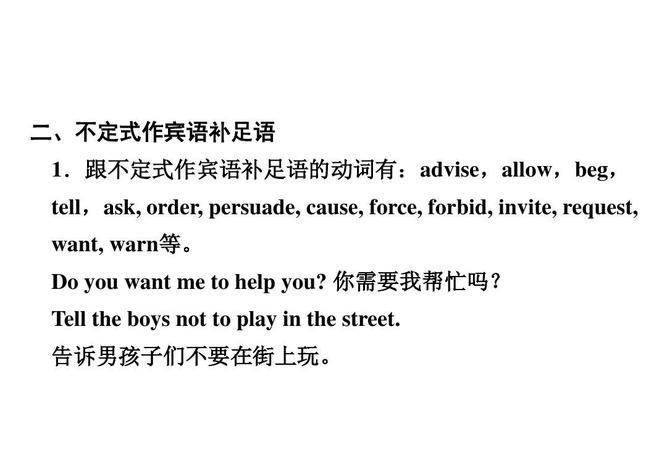本文目录
英语补语有哪些类型
英语补语一般是宾语补语,有以下类型。
1、不定式(to do)
例句1:Our father will not allow us to play on the street.父亲不让我们在街上玩耍。
例句2:We believe him to be guilty.我们相信他是有罪的。
2、名词
例句1:At the meeting we elected him monitor.在会议上我们选他做班长。
例句2:I name my dog Pit.我叫我的狗Pit。

3、形容词
例句1:What you said made Xiao Wang angry.你所说的使小王很生气。
例句2:I found the classroom empty.我发现教室里空无一人。
4、副词
例句1:Please call the students back at once.请马上回电话给学生。
例句2:He was seen to take his cap off.他脱下他的帽子。
5、现在分词
例句1:We hear him singing in the hall.我们听到他在大厅里唱歌。
例句2:I found him lying in bed and sleeping.我发现他躺在床上,正在睡觉。
英语动词不定式作宾语的句子
这里it作形式宾语,因为实际的宾语是不定式短语,不定式短语过长,所以后置,语法句子结构上和谐一点。
而important作宾语补足语,补充说明宾语(也就是不定式短语)。如果在important前面加is,那么it就变成从句中的形式主语了,后面的不定式作真正的主语,而后面整体就是一个做think的宾语从句,省略了引导词that.
We think (that) it is important to learn English.

英语动词不定式,动名词的用法和区别
动词不定式
英语语法--动词不定式
动词不定式
7.1 不定式作宾语
1) 动词+ 不定式
afford aim appear agree arrange ask be decide bother care choose come dare demand desire determine expect elect endeavor hope fail happen help hesitate learn long mean manage offer ought plan prepare pretend promise refuse seem tend wait wish undertake
举例:
The driver failed to see the other car in time.
司机没能及时看见另一辆车。
I happen to know the answer to your question.
我碰巧知道你那道问题的答案。
2)动词+不定式 ; 动词+宾语+不定式
ask, beg, choose, expect , hate, help intend like, love, need prefer, prepare, promise, want, wish…
I like to keep everything tidy. 我喜欢每件东西都保持整洁。
I like you to keep everything tidy. 我喜欢你年使每件东西都保持整洁。
I want to speak to Tom. 我想和汤姆谈话。
I want you to speak to Tom. 我想让你和汤姆谈话。
3) 动词+疑问词+ to
decide, know, consider forget, learn, remember, show, understand, see, wonder, hear, find out, explain, tell
Please show us how to do that. 请演示给我们如何去做。
There are so many kinds of tape-recorders on sale that I can’t make up my mind which to buy.有这么多的录音机,我都拿不定主意买哪一种。
注意:疑问词带不定式在句中作成分时,谓语动词用单数。
The question is how to put it into practice.
问题是怎样把它付诸实施。
7.1 不定式作宾语
1) 动词+ 不定式
afford aim appear agree arrange ask be decide bother care choose come dare demand desire determine expect elect endeavor hope fail happen help hesitate learn long mean manage offer ought plan prepare pretend promise refuse seem tend wait wish undertake
举例:
The driver failed to see the other car in time.
司机没能及时看见另一辆车。
I happen to know the answer to your question.
我碰巧知道你那道问题的答案。
2)动词+不定式 ; 动词+宾语+不定式
ask, beg, choose, expect , hate, help intend like, love, need prefer, prepare, promise, want, wish…
I like to keep everything tidy. 我喜欢每件东西都保持整洁。
I like you to keep everything tidy. 我喜欢你年使每件东西都保持整洁。
I want to speak to Tom. 我想和汤姆谈话。
I want you to speak to Tom. 我想让你和汤姆谈话。
3) 动词+疑问词+ to
decide, know, consider forget, learn, remember, show, understand, see, wonder, hear, find out, explain, tell
Please show us how to do that. 请演示给我们如何去做。
There are so many kinds of tape-recorders on sale that I can’t make up my mind which to buy.有这么多的录音机,我都拿不定主意买哪一种。
注意:疑问词带不定式在句中作成分时,谓语动词用单数。
The question is how to put it into practice.
问题是怎样把它付诸实施。
7.2 不定式作补语
1) 动词+宾语+不定式(to do)
advise allow appoint believe cause challenge command compel consider declare drive enable encourage find forbid force guess hire imagine impel induce inform instruct invite judge know like order permit persuade remind report request require select send state suppose tell think train trust understand urge warn
例句:
a. Father will not allow us to play on the street.
父亲不让我们在街上玩耍。
b. We believe him to be guilty.
我们相信他是有罪的。
Find 的特殊用法:
Find 后可用分词做宾补,或先加形式宾语,再加形容词,最后加带to 的动词不定式。find后也可带一个从句。此类动词还有get,have。
I found him lying on the ground.
I found it important to learn.
I found that to learn English is important.
典型例题:
The next morning she found the man ___ in bed,dead.
A. lying B. lie C. lay D. laying
答案:A.find的宾语后面,用分词或分词短语,起宾语补足语作用。现在分词表达主动,也表达正在进行,过去分词表达被动。
2) to + be 的不定式结构,作补语的动词。
Acknowledge, believe, consider, think, declare(声称), discover, fancy(设想), feel find, guess, judge, imagine, know, prove, see(理解), show, suppose, take(以为), understand
We consider Tom to be one of the best students in our class.
我们认为汤姆是班上最好的学生之一。
典型例题
Charles Babbage is generally considered ___ the first computer.
A. to invent B. inventing C. to have invented D. having invented
答案:A. 由consider to do sth. 排除B、D。. 此句只说明发明这一个事实,不定式后用原形即可。而C为现在完成时,发明为点动词一般不用完成时,且此处也不强调对现在的影响,因此不选C。
3) to be +形容词
Seem, appear, be said, be supposed, be believed, be thought, be known, be reported, hope, wish, desire, want, plan, expect, mean…
The book is believed to be uninteresting.
人们认为这本书没什么意思。
4) there be+不定式
believe, expect, intend, like, love, mean, prefer, want, wish, undrstand
We didn’t expect there to be so many people there.我们没料到会有那么多人在哪里。
注意 : 有些动词需用as 短语做补语,如regard, think believe, take, consider.
We regard Tom as our best teacher. 我们认为汤姆是我们最好的老师。
Mary took him as her father . 玛丽把他当作自己的父亲。
7.3 不定式主语
1) It’s easy (for me) to do that.我做这事太容易了
easy, difficult, hard, important, possible, impossible, comfortable, necessary, better;
the first, the next, the last, the best, too much, too little, not enough
It’s so nice to hear your voice.
听到你的声音真高兴。
It’s necessary for you to lock the car when you do not use it.
当你不用车的时候,锁车是有必要的。
2) It’s very kind of you to help us. 他帮助我们,他真好。
Kind, nice, stupid, rude, clever, foolish, thoughtful, thoughtless, brave, considerate(考虑周到的), silly, selfish(自私的)
例句:
It was silly of us to believe him. 我们真愚蠢,竟然相信了他。
It seemed selfish of him not to give them anything. 他不给他们任何东西,这显得太自私了。
注意:1) 其他系动词如,look,appear等也可用于此句型
2) 不定式作为句子成分时,动词用单数形式。
3) 当不定式作主语的句子中又有一个不定式作表语时,不能用It is… to…的句型
(对)To see is to believe. 百闻不如一见。
(错)It is to believe to see.
7.4 It’s for sb.和 It’s of sb.
1)for sb. 常用于表示事物的特征特点,表示客观形式的形容词,如easy, hard, difficult, interesting, impossible等:
It’s very hard for him to study two languages. 对他来说学两门外语是很难的。
2)of sb的句型一般用表示人物的性格,品德,表示主观感情或态度的形容词,如good, kind, nice, clever, foolish, right。
It’s very nice of you to help me. 你来帮助我,你真是太好了。
for 与of 的辨别方法:
用介词后面的代词作主语,用介词前边的形容词作表语,造个句子。如果道理上通顺用of,不通则用for。如:
You are nice. (通顺,所以应用of)。
He is hard. (人是困难的,不通,因此应用for。)
7.5 不定式作表语
不定式可放在be动词后面,形成表语。例如:
My work is to clean the room every day.
His dream is to be a doctor.
7.6 不定式作定语
不定式做定语通常要放在被修饰的词后。例如:
I have a lot of work to do.
So he made some candles to give light.
7.7 不定式作状语
1)目的状语
To… only to (仅仅为了), in order to, so as to, so(such)… as to… (如此……以便……)
He ran so fast as to catch the first bus. 他飞快地跑以便赶上第一班车。
I come here only to say good-bye to you. 我来仅仅是向你告别。
2)作结果状语,表事先没有预料到的,要放在句子后面。
What have I said to make you angry.
He searched the room only to find nothing.
3) 表原因
I’m glad to see you.
过去分词的用法
非谓语动词的用法讲解:
Huzhou No. 2 High School
1. 及物动词的过去分词作表语,与句子主语是被动关系,表示主语的状态,既表示被动,又表示完成.
(1)_ The cup is broken. 茶杯破了.
2. 不及物动词的过去分词作表语,与句子主语是主动关系,表示主语的状态,只表示动作的完成.
(2) He is retired. 他已退休.
3. 有些过去分词作表语时,构成的谓语很接近被动结构.
(3)_The city is surrounded on three sides by mountains. 这座城市三面环山.
过去分词作表语
【注意】过去分词作表语与被动语态的区别:过去分词作表语,主要是表示主语的状态,而被动语态则表示动作.
(1) The cup was broken by my little sister yesterday. 茶杯是昨天我小妹打碎的.(是被动语态,表示动作)
(2) The library is now closed. 图书馆关门了.(过去分词作表语)
【注意】过去分词表示被动或完成, -ing 形式表示主动或进行.有些动词如 interest, bore, worry, surprise, frighten 等通常用其过去分词形式来修饰人,用 -ing 形式来修饰物.
(3) The book is interesting and I'm interested in it. 这本书很有趣,我对它很感兴趣.
过去分词作定语
作定语用的过去分词相当于形容词,其逻辑主语就是它所修饰的名词.及物动词的过去分词作定语,既表被动又表完成;不及物动词的过去分词作定语,只表完成.
1. 过去分词用作定语,如果是单个的,常置于其所修饰的名词之前.
We must adapt our thinking to the changed conditions. 我们必须使我们的思想适应改变了的情况.
2. 过去分词短语用作定语时,一般置于其所修饰的名词之后,其意义相当于一个定语从句,但较从句简洁,多用于书面语中.
The concert given by their friends was a success.他们朋友举行的音乐会大为成功.
3.过去分词短语有时也可用作非限制性定语,前后常有逗号.
(1)The meeting, attended by over five thousand people, welcomed the great hero. 他们举行了欢迎英雄的大会,到会的有五千多人.
4. 用来修饰人的过去分词有时可以转移到修饰非人的事物,这种过去分词在形式上虽不直接修饰人,但它所修饰的事物仍与人直接有关.
(2) The boy looked up with a pleased expression. 男孩带着满意的表情举目而视.
过去分词作状语
1. 过去分词作状语过去分词作状语表示被动的和完成的动作.
(1) Written in a hurry, this article was not so good! 因为写得匆忙,这篇文章不是很好.
【注意】written 为过去分词作状语,表示这篇文章是被写的,而且已经被写. 值得注意的是,有些过去分词因来源于系表结构,作状语时不表被动而表主动.这样的过去分词及短语常见的有: lost (迷路); seated (坐); hidden (躲); stationed (驻扎); lost / absorbed in (沉溺于); born (出身于); dressed in (穿着); tired of (厌烦).
(2) Lost / Absorbed in deep thought, he didn't hear the sound.因为沉溺于思考之中,所以他没听到那个声音.
2. 过去分词作状语时其逻辑主语为主句的主语,此时应注意人称一致.
(1) Given another hour, I can also work out this problem.
再给我一个小时,我也能解这道题.(given 为过去分词作状语,它的逻辑主语为主句主语 I ,即 I 被再给一个小时.)
(2)_ Seen from the top of the hill, the city looks more beautiful to us.
从山顶看城市,城市显得更漂亮.(seen 为过去分词作状语,表"被看",由语境可知,它的逻辑主语必须是城市,而不是"我们",因为"我们"应主动看城市.)
【注意】如果过去分词作状语时,前面再加逻辑主语,主句的主语就不再是分词的逻辑主语,这种带逻辑主语的过去分词结构实际上属于独立主格结构.
(1) The signal given, the bus started. 信号一发出,汽车就开动了.(the signal 是 given 的逻辑主语,因此主句主语 the bus 就不是given 的逻辑主语.
(2) Her head held high, she went by. 她把头昂得高高地从这儿走了过去.(her head 是 held high 的逻辑主语,因此主句主语 she 就不再是held high 的逻辑主语.)
3. 过去分词作状语来源于状语从句.
(1) Caught in a heavy rain, he was all wet. 因为淋了一场大雨,所以他全身湿透了. (caught in a heavy rain 为过去分词短语作原因状语,它来源于原因状语从句 Because he was caught in a heavy rain.)
(2)_Grown in rich soil, these seeds can grow fast. 如果种在肥沃的土壤里,这些种子能长得很快.( grown in rich soil 为过去分词作条件状语,它来源于条件状语从句 If these seeds are grown in rich soil.
【注意】状语从句改成过去分词作状语时有时还可保留连词,构成"连词+过去分词"结构作状语.
When given a medical examination, you should keep calm. 当你做体格检查时要保持镇定.
4. 过去分词作状语的位置.过去分词可放在主句前作句首状语,后面有逗号与主句隔开;也可放在主句后面,前面有逗号与主句隔开.
He stood there silently, moved to tears. = Moved to tears, he stood there silently. 他静静地站在那里,被感动得热泪盈眶.
过去分词作宾语补足语
(一)能够接过去分词作宾补的动词有以下三类:
1. 表示感觉或心理状态的动词.如:see, watch, observe, look at, hear, listen to, feel, notice, think等.
(1) I heard the song sung in English. 我听到有人用英语唱过这首歌.(过去分词sung的动作显然先于谓语动作heard;)
(2)_He found his hometown greatly changed. 他发现他的家乡变化很大.(过去分词changed的动作显然先于谓语动作found)
2. 表示"致使"意义的动词.如:have, make, get, keep, leave等.
(1) I'll have my hair cut tomorrow. 明天我要理发.
(2) He got his tooth pulled out yesterday. 他昨天把牙拔了.
(3) Don't leave those things undone. 要把那些事情做完.
【注意】过去分词所表示的动作一定和宾语有逻辑上的动宾关系.
(二)使役动词have接过去分词作宾补有两种情况.
1. 过去分词所表示的动作由他人完成.
(1) He had his money stolen.他的钱给偷了.(被别人偷去了)
2. 过去分词所表示的动作由句中的主语所经历.如:
(2) He had his leg broken.他的腿断了. (自己的经历)
"with +宾语+过去分词"结构
"with +宾语+过去分词"结构中,过去分词用作介词 with的宾语补足语.这一结构通常在句中作时间,方式,条件,原因等状语.例如:
(1) The murderer was brought in, with his hands tied behind his back. 凶手被带进来了,他的双手被绑在背后.(表方式)
(2) With water heated, we can see the steam. 水一被加热,我们就会看到水蒸气.(表条件)
(3) With the matter settled, we all went home. 事情得到解决,我们都回家了.(表原因)
(4)_She stood in front of him, with her eyes fixed on his face. 她站在他面前,眼睛注视着他.
(5) He stood for an instant with his hand still raised. 他仍然举着手站了一会儿.

不定式作动词宾语的例句
如下:
1、To see a world in a grain of sand. And a heaven in a wild flower.
从一粒沙子看到一个世界,从一朵野花看到一个天堂。
2、Hold infinity in the palm of your hand. And eternity in an hour.
把握在你手心里的就是无限,永恒也就消融于一个时辰。
3、Life is a chain of moments of enjoyment, not only about survival.
生活是一串串的快乐时光,我们不仅仅是为了生存而生存。

4、To the world you may be one person, but to one person you may be the world.
对于世界而言,你是一个人;但是对于某个人,你是他的整个世界。
5、Never frown, even when you are sad, because you never know who is falling in love with your smile.
纵然伤心,也不要愁眉不展,因为你不知道是谁会爱上你的笑容。
以上就是关于不定式作补语的英语例句 ,英语补语有哪些类型的全部内容,以及不定式作补语的英语例句 的相关内容,希望能够帮到您。

